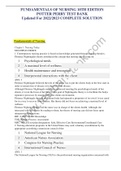Samenvatting
Samenvatting Operations and Supply chain management ~ The core
- Instelling
- Tilburg University (UVT)
It is a summary of the book "Operations and supply chain mangamen ~ the core". It contains the chapters: 1,2,3,4, 4a, 6,6a, 8,9,11,13 and 14.
[Meer zien]









